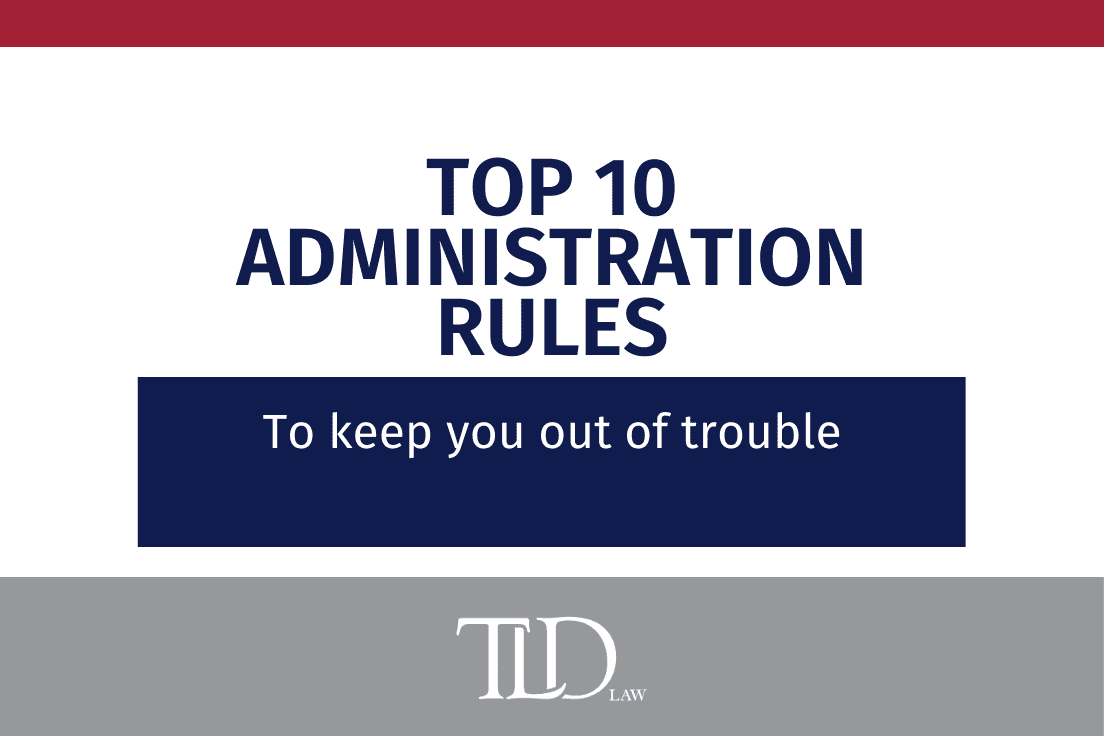
Top Ten Trust Administration Rules to Keep You out of Trouble
By Mark Doyle, Esq. and Monica Goel, Esq. Partners at TLD Law
People have become educated to know that estate planning is important. Without it, your life savings and estate will go through the cost and expense of probate court. With estate planning, you can do advanced tax planning to avoid the cost and expense of probate, avoid costly estate taxes, and ensure smooth transition of assets to your heirs.
Trust administration is just as important. When someone passes away, it’s imperative that the proper trust administration is done to carry out the terms of the Trust. This is demonstrated in the recent Wall Street Journal article “When Dad Amasses a Fortune.†http://webreprints.djreprints.com/3194370992896.htm
Now more than ever, it’s important to understand how trust administration works.
Here are 10 simple rules to follow:
1. Determine Who is the Client
It is extremely important to know who your client is. If you are meeting with the Successor Trustee of a Trust, meet with them alone. Do not meet with beneficiaries and give them the impression that you represent them as well or the “Trust.†You represent the Trustee of the Trust.
When a non-client believes that an attorney is their attorney, there is a risk that the non-client is now owed fiduciary duties by that attorney. If representation of the non-client presents a conflict of interests with the attorney’s current clients, then the attorney may be facing another potential ethical violation in representing conflicting interests without proper disclosure, or alternatively, the attorney is forced to withdraw from representing both clients whose interests’ conflict. Thus, it is just as important for an attorney identify to whom they owe fiduciary duties as it is for the attorney to identify to whom they do not owe such duties in order to prevent an unintended attorney/client relationship.
2. Avoid Conflicts of Interest
Be wary of known, unknown, and actual conflict of interest. You cannot represent both the Trustee and beneficiaries of the Trust. Make sure to obtain a conflict waiver if representing co-trustees. Be sure they understand that you will have to withdraw as counsel if a conflict arises between them. If you are the drafting estate planning attorney of the Trust, you cannot represent beneficiaries in their attempt to contest the Trust. Be cautious if it appears you may be a percipient witness in the matter.
An attorney has the following duties, among others, to the client he or she represents: undivided loyalty, avoiding representing adverse interests, keeping the client informed, and maintaining client confidences. Undivided loyalty and avoiding representation of conflicting interests goes hand in hand. A conflict of interest is broadly defined as a situation that interferes with a lawyer’s ability to fulfill basic duties to a client. State Bar Formal Opinion No. 1982-69.
Conflicts of interest may arise in probate and trust proceedings because of the interrelatedness of parties and the multiple roles of individual parties and beneficiaries, fiduciaries, or business associates. Consideration of potential conflicts is particularly important, because, as is common, the attorney may have represented the decedent, decedent’s spouse or family members or consulted with decedent in business transactions and these parties may have conflicting interests with regard to decedent’s estate. In trust and probate cases in particular, a conflict of interest may arise after the representation has been accepted, requiring independent counsel for the various interested persons.
3. Know the Process
We break down the trust administration process into 3 stages:
Notification and Marshaling Assets
Inventory & Appraisal
Allocation or Distribution
On the death of settlor/trustee, Probate Code Section 16061.7 requires that the Successor Trustee send out a notification to all heirs at law regarding their rights to obtain copies of the Trust documents and contest them. The Trustee is required to give Notice to all beneficiaries under the Trust and all heirs of the decedent. This Notice is required to be sent within 60 days of the decedent’s death. Upon the first death, the successor Trustee is only required to provide the irrevocable terms of the Trust. Some attorneys send the terms of the Trust with the Notice, although not required. If any possible litigation is anticipated, the Notification should be sent via certified mail.
It is important to obtain a new tax payer identification number for the Trust as the assets cannot remain in the social security number of the decedent nor in that of the Trustee. Complete the IRS Form SS-4. This form is required to be executed by the successor trustee prior to obtaining a taxpayer identification number for any subtrust(s) which are required to be funded. The successor Trustee will appoint the attorney as the “Third Party Designee†in order to obtain the new identification number over the IRS website.
During the initial client meeting, you should have been provided with most of the date of death statements requested in your initial confirmation letter. However, it is unlikely that any appraisals have been completed.
If an estate tax return is anticipated to be filed, a certified appraisal should be obtained based on the market value of any real property as of the date of death. Any stock holdings are valued based on the average of the high and low stock price on the date of death. The Trustee may also need to obtain the value of specific items of personal property of the decedent, such as coins, stamps, jewelry, vehicles, farm equipment, art and antiques. In determining the title of the various assets, you will want to determine if any small estate affidavits need to be prepared under Probate Code Section 13100. If a probate needs to be commenced or a petition under Hegstaad could remedy any assets not held properly in the name of the Trust.
Affidavits Re: Death of a Trustee or Co-Trustee must be recorded to allow new Successor Trustee to take title to property. Declarations must be recorded in the County where the decedent owned property. The County Assessor requires a Preliminary Change in Ownership Report to prevent reassessment upon change in Trustee. Claim for Reassessment Exclusions for Transfers Between Parents and Children must be submitted separately to each County where the decedent owned property passing to children as beneficiaries. These forms should be sent via certified mail and request the assessor confirm and return a copy of the same as proof of receipt. Failure to timely submit these forms can result in reassessment of real property and a substantial increase in annual property taxes. California Proposition 58 permits exclusion from reassessment of real property passing to children limited to the principle residence of the parent and or the first $1,000,000 of other real property. A similar exemption is available for transfers between grandparents and grandchildren only when the parent of the grandchild has predeceased the grandparent and the deceased parent was not married at the time of death.
Trust Certifications and instructions need to be provided to any financial institutions managing accounts in the name of the Trust. Since the surviving spouse is most likely named as a Co-Trustee on the accounts, the re-registration should simply involve removing the deceased spouse’s name and changing the taxpayer identification number. Not all financial institutions have the same policies and the successor trustee may be required to complete new account applications and establish new accounts.
Be sure to conclude the administration with either a sub-trust allocation agreement or distribution agreement. Strongly advise Trustees to prepare and circulate a Distribution Agreement. These agreements set forth distribution provisions. They often contains waiver of formal accounting. They set forth the value of Trust assets and distributions to individual beneficiaries or sub-trusts. When making distributions, they contain release of liability for Trustee and provides for final trust termination
4. Know your Limits
Only take cases you are comfortable handling. If the matter requires litigation or tax expertise which you don’t have, you may need to refer the case out or associate in counsel. Do not take cases you are not experienced in handling.
5. Communicate
Communicate with your client. Make sure they understand their fiduciary duties to all beneficiaries, keep meticulous records for an accounting, and invest prudently.
Beneficiaries of an irrevocable Trust are entitled to an accounting of the Trust assets at least annually. This accounting can be waived in writing and is not required if the sole trust beneficiary and the trustee are the same person. Other people who have a future interest in the trust, even though the interest is remote, may demand and receive an accounting each year. Trust beneficiaries also have the right to request certain information such as assets on hand, sales, purchases, etc., from the trustee.
The successor trustee(s) should be advised to gather all of the decedent’s mail. Provide the post office with a certified death certificate and copies of the trustee provisions of the Trust. In this regard, a Trust Certification should suffice. The mail is essential to gathering as much information as possible regarding the assets of the decedent, especially if the decedent did not keep organized files. Request the successor trustee to bring as much information as possible to the initial meeting. The determination of their relevance can be determined by the attorney.
6. Act with Diligence
Time is of the essence. Be sure to follow up with your client and be cognizant of deadlines including the due date for the estate tax return and deadline to exercise a disclaimer. Although the length of administration is a “reasonableness period,†the longer it drags out the more likely suspicion and litigation are likely to erupt.
7. Identify Sub Trusts and Need for Administrative Trust
Trust administration is in most cases a transfer of assets which is by its nature a taxable event.
Income produced by trust assets will continue during the period of trust administration so a timely decision should be made regarding how income will be reported. Usually obtaining valuation of the assets and handling of bequests will prevent an immediate funding of marital, bypass or children’s sub trusts. In the meantime a decision must be made between either the pass through method or administrative trust method.
Under the pass through method the trust is ignored and the all trust income is taxed to the sub trusts or beneficiaries beginning with the date of death. If the estate is not large or if funding will occur within the calendar year the pass through approach saves costs and administrative time.
The administrative trust approach treats the trust estate as a separate taxpayer between the date of death and the date that the separate trusts are funded. Under this approach a separate taxpayer identification number is obtained and a 1041 fiduciary tax return filed for the administrative trust.
8. Comply with Tax Filing Requirements
Under IRC 6075(a) an estate tax return IRS Form 706 must be filed within nine months after the date of the decedent’s death. Although the return is due within nine months, an automatic filing extension of an additional six months is available. The automatic extension does relief the taxpayer of the obligation to pay estate tax due within nine months of the decedent’s death.
While a return is only due for a decedent whose gross estate exceeds the applicable exclusion amount (currently $5,250,000.00) other factors including the portability election may require filing. See Below. Generation Skipping Tax Elections are also required on a timely filed estate tax return.
9. Be Aware of the New Portability Election.
The new portability election IRC 2010(c) allows the surviving spouse to add the deceased spouse’s unused exemption amount at the second death.
This is some cases will allow a married couple to avoid using the traditional A/B trust. It gives married couples more flexibility in deciding how to use their exclusion amounts. Under IRC 23 For example, the first spouse to die could give everything to the other spouse without incurring estate tax by virtue of the unlimited marital deduction and the estate could transfer the unused exclusion to the survivor to use in making gifts or at death. However, use of a traditional two-trust plan combining a marital deduction trust with a credit shelter trust may be preferable. A credit shelter trust can prevent post- transfer appreciation in the value of the assets from being subject to estate tax on the survivors’ death. By contrast, an exclusion transferred to a surviving spouse is fixed and may not be sufficient to shield post-transfer appreciation from tax. In addition, a credit-shelter trust can protect assets from being squandered by the surviving spouse and protect against creditors. To take advantage of the portability election the surviving spouse must file a timely estate tax return for the deceased spouse.
10. Understand the Impact of Trust Funding on Income and Property Tax
Under IRC 1014 the basis of property inherited is stepped up to fair market value at the date of decedent’s death. For a couple in California with community property the entire value of the community estate receives a step up. Exceptions to this important benefit include retirement assets and assets gifted prior to death. When administering a trust also note that assets funded into an exemption trust will not receive another step up on the surviving spouse’s death.
In California careful attention needs to also be paid to avoid a real property tax assessment on the transfer to heirs. Staying within the parent child exclusion rules for Prop 13 is critical and appropriate claims should be filed with any title transfers







